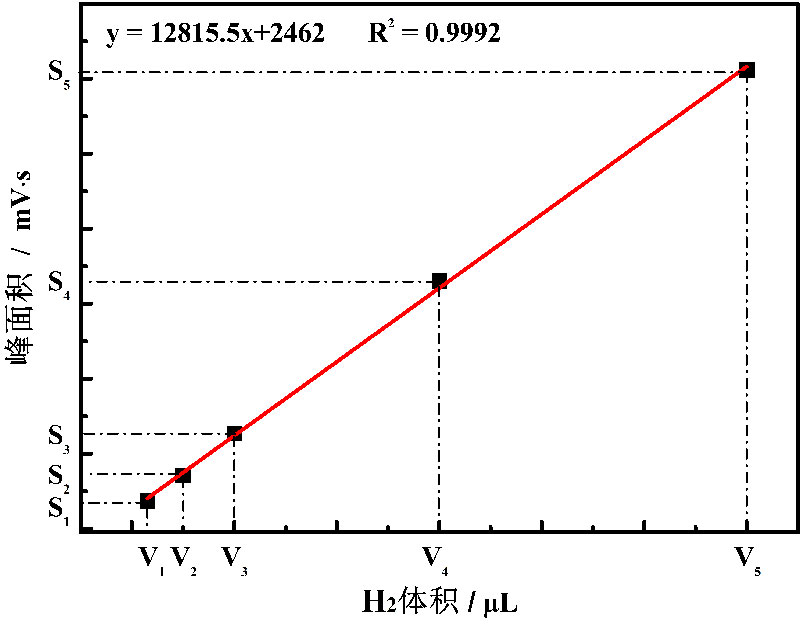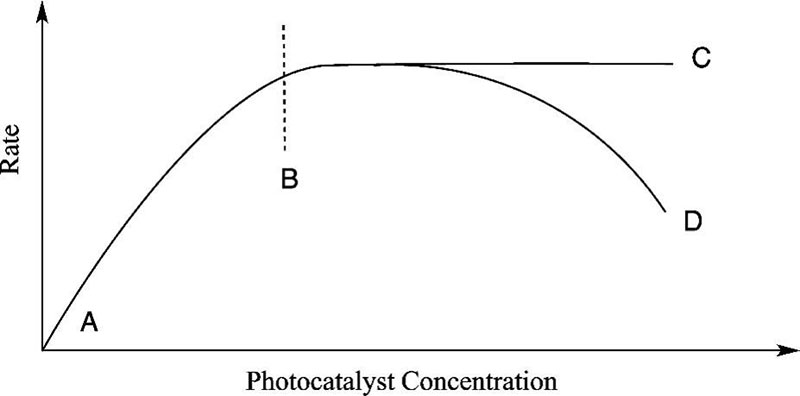In the activity evaluation system of photocatalytic water splitting reactions, in addition to apparent quantum yield and solar-to-hydrogen (STH) energy conversion efficiency, there is also a simple parameter used to evaluate the activity of photocatalysts for water splitting—hydrogen production rate (v, μmol·h-1 or mmol·h-1). In photocatalytic water splitting experiments, the hydrogen production rate refers to the amount of hydrogen produced per unit time, and it is calculated using the following formula:

In photocatalytic water splitting experiments, the quantity of H₂ gas is typically determined using gas chromatography. The data obtained from gas chromatography is in the form of peak area (μV·s), and the raw peak area itself does not have direct quantitative meaning. In this case, quantitative analysis of H₂ is performed using an external standard curve through the "external standard method". The standard curve represents the trend of the chromatographic peak area as a function of the volume/quantity of the substance being analyzed. Therefore, before quantifying H₂, it is necessary to first establish a standard curve.
Inject a known volume V1 of high-purity H₂ gas into the photocatalytic water splitting system, allow for uniform circulation, and then detect and record the peak area S1 using gas chromatography. Subsequently, sequentially inject known volumes (V₂-V1), (V₃-V₂), (V₄-V₃), and (V₅-V₄) mL of high-purity H₂ gas into the system (accumulative injection), obtaining peak areas S₂, S₃, S₄, and S₅. By plotting the chromatographic peak area (S) against the volume of H₂ (V), the original data points for the standard curve can be obtained. After linear fitting, the standard curve is established. The goodness of fit (R2) of the standard curve should be equal to or greater than 0.999, as shown in Figure 1. Additionally, the range of H₂ volume points on the standard curve should encompass the actual hydrogen production quantity of the photocatalytic water splitting experiment, but the range should not be excessively wide to ensure linearity between peak area and H₂ volume.

Figure 1: Example of Hydrogen Production Rate Standard Curve
Using the established standard curve, the measured chromatographic peak area from the photocatalytic water splitting experiment can be substituted into the equation to calculate the volume of H₂ generated during the reaction. Dividing the calculated H₂ volume by 22.4 L·mol-1 gives the quantity of H₂ substance produced in the photocatalytic water splitting experiment. Dividing the quantity of H₂ substance by the reaction time yields the hydrogen production rate for the photocatalytic water splitting experiment. Have you understood so far?
Generally, it is customary to normalize the obtained hydrogen production rate by mass (μmol·h-1·g-1 or mmol·h-1·g-1). However, in non-homogeneous catalytic reaction systems, as the catalyst concentration increases, the reaction rate may reach a maximum value and remain constant, or even decrease, due to reduced light penetration depth and increased scattering of incident light, as shown in Figure 2 sections B-C and B-D[1]. Therefore, for non-homogeneous photocatalytic water splitting reactions, expressing the hydrogen production rate in units of μmol·h-1 or mmol·h-1 [2,3] instead of normalized by mass per gram (μmol·h-1·g-1 or mmol·h-1·g-1) provides a more accurate representation of catalyst activity.

Figure 2: Effect of Catalyst Concentration on Reaction Rate[1]
[1]Horst Kisch*, On the problem of comparing rates or apparent quantum yields in heterogeneous photocatalysis[J]. Angewandte.Chemie. International. Edition. 2010, 49, 9588.
[2]Chen Shanshan, Vequizo Junie Jhon M., Domen Kazunari* et. al., Surface modifications of (ZnSe)0.5(CuGa2.5Se4.25)0.5 to promote photocatalytic Z-Scheme overall water splitting[J]. Journal of the American Chemical Society, 2021, 143, 10633.
[3]Ren Xiaohui, Weisongrui, Ye Jinhua* et. al., Rational construction of dual cobalt active species encapsulated by ultrathin carbon matrix from MOF for boosting photocatalytic H2 generation, Applied Catalysis B: Environmental, 2021, 286, 119924.